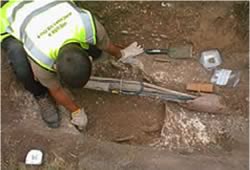
The South (West Kennet) Avenue at Avebury is part of one of the greatest surviving concentrations of monuments from the Neolithic (4000-2000 BC) and Bronze Age (2400-700 BC) in Western Europe.
British Telecom cables, running alongside the road parallel to the Avenue, need updating. So Bob Davis of Wessex Archaeology was asked to work with the BT engineer to record any significant finds uncovered during the maintenance work.
While digging under the cable trench to the north end of the Avenue, Bob uncovered a small pit containing cattle bones and fragments of pottery. Similar pits had been discovered in the 1930s when Alexander Keiller carried out investigations between the stones of the Avenue and within the great henge itself.
The exact date and function of these pits has remained a mystery. The deposits follow a similar pattern, with cattle bones and pottery sherds placed deliberately within the pits, suggesting that a ritual has taken place.
The pottery in this pit, as in many others in the area, is of a type known as Mortlake pottery, dating between 3400-2500 BC.
The cattle bones are being sent for radiocarbon dating which will give useful information not only about this newly discovered pit, but also about the ones dug some 70 years ago when such precise dating tests were not available.
School children from three local primary schools were at Avebury taking part in an education project with Wessex Archaeology and World Heritage Sites. They had an unexpected treat when they were invited to handle objects fresh from the ground where they had been buried for more than 4,000 years.
See the full story at http://www.wessexarch.co.uk/projects/wiltshire/avebury/index.html